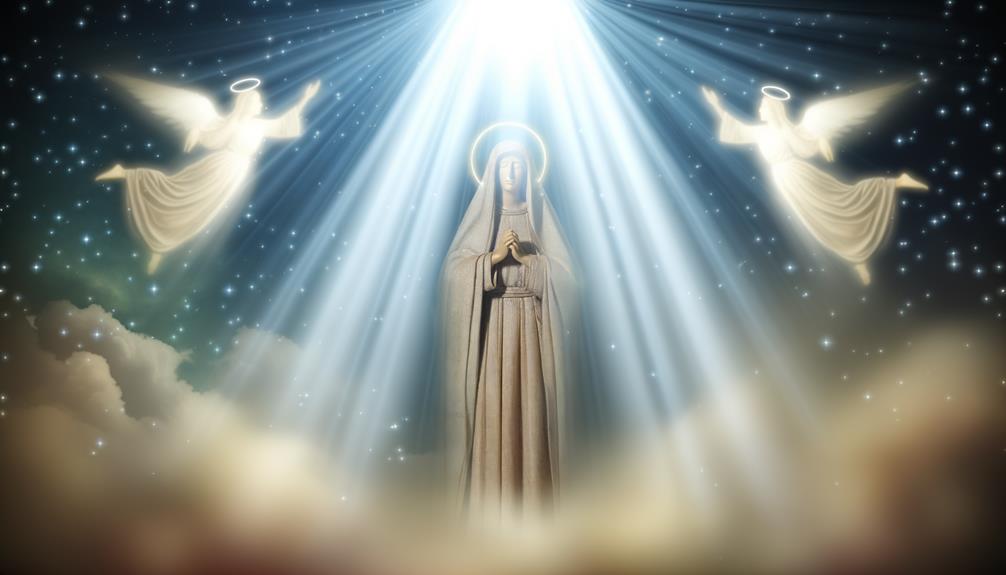Hail Mary Meaning in Bible: Prayer and Hope
The phrase ‘Hail Mary‘ originates in the Gospel of Luke, where Angel Gabriel greets Mary with “Hail, full of grace.” This salutation underscores Mary’s unique role and divine favor in the Christian narrative, marking her as a pivotal figure in the fulfillment of God’s promise. The phrase “full of grace” points to her spiritual completeness and deep connection with God, setting the stage for the Incarnation of Jesus Christ.
This moment crystallizes Mary’s veneration within Christian theology, embodying her as a model of faith and a symbol of grace. For a deeper understanding, consider the broader theological and devotional practices associated with Mary.

Hail Mary Meaning in the Bible: Biblical Roots and Spiritual Significance
| Aspect | Biblical Interpretation |
|---|---|
| Phrase Origin | From the angel Gabriel’s greeting to Mary (Luke 1:28) |
| Key Scripture | Luke 1:28–30, Luke 1:42 |
| Literal Meaning | A greeting recognizing Mary’s favor and blessing by God |
| Spiritual Significance | Honors Mary’s role in the incarnation of Jesus |
| Devotional Use | Central prayer in Catholic tradition, reflecting reverence and intercession |
| Theological Insight | Affirms Mary’s obedience and unique place in God’s salvation plan |
Biblical Origins

The phrase ‘Hail Mary‘ finds its biblical origins in the Gospel of Luke, where the angel Gabriel greets Mary with the words, ‘Hail, full of grace, the Lord is with thee.’
This salutation is significant as it marks a divine acknowledgment of Mary’s unique role within Christian theology. The term ‘full of grace’ conveys a spiritual completeness, suggesting that Mary is specially favored by God.
The greeting encapsulates theological notions of divine election and sanctity, positioning Mary as a pivotal figure in the narrative of salvation.
Understanding this biblical context is vital for comprehending the reverence accorded to Mary in Christian traditions, as it underpins her veneration and the doctrinal foundations of Marian devotion.
Angel Gabriel’s Greeting

Angel Gabriel’s greeting to Mary is a profound moment that encapsulates both divine intention and theological significance within the Christian narrative.
Luke 1:28 records the angel’s salutation, ‘Hail, full of grace, the Lord is with thee.’ This greeting is not merely a formality but signifies Mary’s unique role in salvation history.
The term ‘full of grace’ suggests a special divine favor, indicating that Mary has been chosen for an extraordinary purpose. Gabriel’s message also emphasizes God’s active presence in her life, foreshadowing the incarnation of Jesus Christ.
This encounter, consequently, marks the inception of the New Covenant fulfillment of Old Covenant prophecies, underscoring Mary’s singular position in the divine plan of redemption.
Marian Devotion

Mary’s unique role in salvation history, as highlighted by Gabriel’s greeting, forms the foundation for centuries of Marian devotion within the Christian tradition. This devotion is expressed through various practices and theological reflections, underscoring her significance in the narrative of redemption. The veneration of Mary serves multiple purposes: as a model of faith, an intercessor, and a symbol of divine grace.
| Aspect | Description | Significance |
|---|---|---|
| Model of Faith | Emulated for her unwavering belief | Inspires believers to trust in God |
| Intercessor | Prayed to for guidance and support | Acts as a mediator between God and humans |
| Symbol of Grace | Represents purity and divine favor | Embodies the ideal of Christian holiness |
Such devotion is not merely sentimental but deeply rooted in theological and historical contexts.
Theological Implications

Examining the theological implications of the Hail Mary reveals intricate connections between Marian doctrines and core Christian beliefs about salvation and grace.
The prayer encapsulates the veneration of Mary as Theotokos, or God-bearer, affirming her role in the divine plan of salvation.
By addressing Mary as ‘full of grace,’ the Hail Mary underscores the belief in her Immaculate Conception, which holds that she was preserved from original sin from the moment of her conception.
Additionally, the invocation ‘pray for us sinners‘ highlights Mary’s intercessory role, reflecting the Catholic understanding of the communion of saints.
This theological framework situates Mary not merely as a passive vessel but as an active participant in the redemptive mission of Christ.
Prayer’s Significance

How does the Hail Mary prayer function within the broader context of Christian devotional practice and theological reflection?
The Hail Mary prayer holds profound significance in Christian spirituality, embodying both devotion and theological nuance. Its recitation serves multiple purposes:
- Marian Devotion: It honors Mary, the mother of Jesus, acknowledging her unique role in salvation history.
- Intercessory Role: Believers seek Mary’s intercession, reflecting her status as a mediatrix.
- Biblical Foundation: The prayer’s words are derived from Scripture, specifically Luke 1:28 and 1:42, giving it a strong biblical grounding.
- Spiritual Discipline: Regular recitation fosters spiritual discipline, enhancing personal piety and communal worship.
Thus, the Hail Mary functions as a multifaceted component of Christian devotion, bridging scriptural tradition with personal and communal spirituality.
Conclusion
The ‘Hail Mary‘ prayer, rooted in the biblical greeting of the Angel Gabriel to Mary, has evolved into a cornerstone of Marian devotion.
Its theological implications underscore the veneration of Mary within Christian practice.
Coincidentally, this prayer’s significance extends beyond mere repetition, serving as a profound expression of faith and intercession.
The prayer’s enduring resonance across centuries highlights its integral role in both personal piety and communal worship, reflecting deep-seated theological and devotional currents within Christianity.






